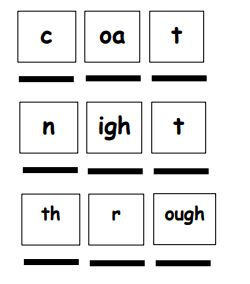Of all the strategies used for teaching reading, I believe that word-building is the most powerful.
Why is that?
- Word-building incorporates two fundamental skills in learning to read: as children build a word, they learn to segment and blend. When we ask children to build a word, e.g., ‘map’ they need to segment the phonemes and then find the letters to represent them. Next, they will sound out the sounds of the letters and blend them into a word.
- Word-building is based on the premise that graphemes are representations of sounds in words not random letters on flash cards – they belong and are used within words.
- When we teach word-building we always use lines, and these help children hear and see the correct order of the sounds. The lines are placeholders for the sounds. This really helps to visualise sounds that can be smooshed together when spoken in words.

- Word-building demystifies the Alphabetic Code. The graphemes on the cards always represent one sound so, as children progress, they move from 1:1 correspondence (one sound/one letter) to 1:2 correspondences (one sound/two letters) and then to 1:3 and 1:4. Because the procedure of word-building is always the same, the only new piece of learning is the new grapheme.

- Word-building is the bedrock of learning to read and spell multisyllabic words. Using the same method of building graphemes within one syllable, children are taught how build each syllable at a time and can clearly see how multisyllabic words work for decoding and encoding.

#teachreading #readingintevention #teachphonics #howtoteachreading #readingtutor


